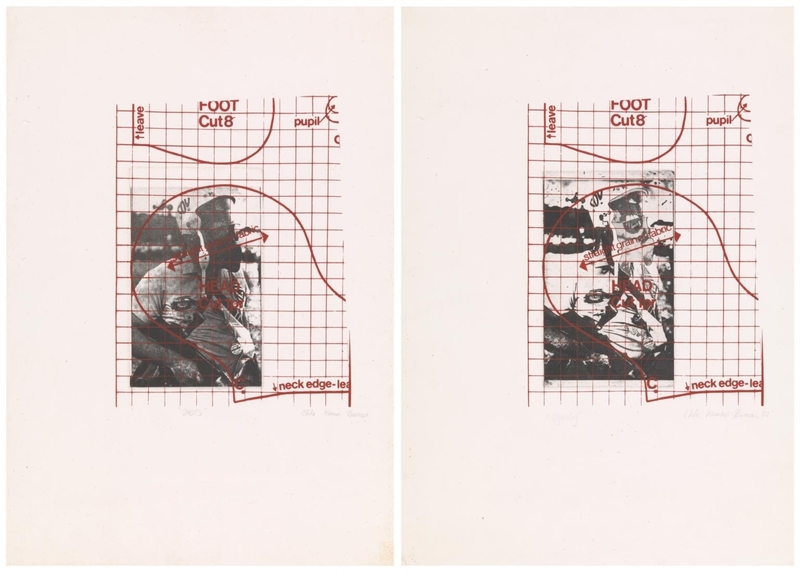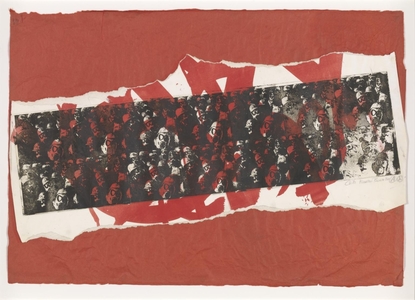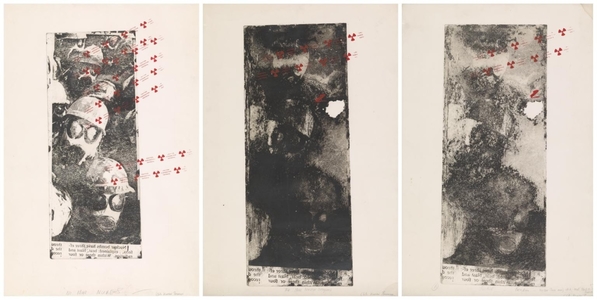When Chila Kumari Singh Burman was a student at The Slade Institute of Art, she witnessed protests across the country against Margaret Thatcher's Conservative government. While a student, Burman was heavily involved in activism alongside her art as an active member of Leeds Housing Centre, Leeds Asian Women's Refuge and the Defence Campaign during the uprisings in the summer of 1981 uprisings.
Burman's art is also a form of political activism. Burman – featured in Tate Britain's recent exhibition 'Women in Revolt!' – was part of a generation of Black British artists working in the 1980s who also used their work to combat societal injustice, such as Sonia Boyce and Lubaina Himid. Burman curated a number of exhibitions of Black artists, contributed to books and journals, and also collaborated with other Black artists on murals such as the 'Southhall Black Resistance mural' with fellow artist Keith Piper.
A series of Burman's prints – which she produced while at the Slade, titled the 'Riot Series' – document widespread anti-Thatcher protests as well as the Campaign for Nuclear Disarmament.
If There is No Struggle, There is No Progress - Uprisings
(Riot Series) 1981
Chila Kumari Singh Burman (b.1957) 
One print from the series, If There is No Struggle, There is No Progress – Uprisings, appears like a map of uprisings by Black and Brown communities against the police in the early 1980s. Handwritten in white ink, Burman has selected some locations of significant protests against the Thatcher government: Chapeltown, Liverpool and Birmingham.
Burman refers specifically to 'Liverpool 8', a series of uprisings which were sparked when police conducted a 'stop and search' on a local man named Leroy Cooper. Referred to in the media as the 'Toxeth riots', the 'stop and search' incident led to rioting between the community and the police in the area.
The artist's reference to the uprisings in Liverpool is particularly poignant. Burman grew up in Liverpool, born to Punjabi parents who had moved there in the 1950s. Acutely aware of the protests in Liverpool, but distant from them while studying in London, these prints may have helped her make sense of the events in her home city by engaging with them in her work.
Burman experimented with a variety of print-making techniques while at the Slade, building up several layers of combined techniques such as etching, silkscreen or lithography. To create Cut – Foot – Pupil – Uprisings, Burman dissolved a photograph of an American policeman in an acid bath to produce a chilling result: the photograph almost resembles a skull from an X-ray.
The print is on a paper dress pattern, where the parts of the items of clothing have been indicated as body parts ('HEAD', 'FOOT', 'PUPIL') with the instruction to cut the fabric into the correct shapes. As part of the sewing pattern, these instructions were harmless, but here they become menacing as the red lines cut through the image of the police officer. The piece has a subtitle – 'Fight Dem Back' – which reads as a call to arms.
Burman worked into her prints with other media. In Red Riots on Indian Paper, she has painted red swirls onto the print, itself on torn white paper and laid at an angle onto the red paper. The colour bleeds through images of riot police in gas masks as if it is overwhelming them, suggesting the success of an uprising or revolution. Burman has described her preference for printmaking over drawing and photography because it feels 'democratic, versatile, colourful, creative, experimental', making it a fitting medium to express political statements.
Images of gas-masked police appear elsewhere in the series. In Triptych No Nukes, the gas masks stare out of the lefthand print. For Burman, each technique and material can be loaded with political power: in No Nukes, for each stage of the triptych, the etching plate was placed in acid for longer periods of time so that the image disintegrated. In the far-right image, the gas masks are barely perceptible, reduced to black smudges.
Lynda Nead – in her book on Burman, Between Two Worlds – has argued that it is like the 'gas-masked police are symbolically nuked' by being put through the chemical process. It is a powerful anti-nuclear statement of 'No Nukes', itself a political rally cry, as it imagines the destructive impact of nuclear warfare as one of total annihilation.
In another triptych, Three Mug Shots in a Row, Burman used a similar technique, altering the saturation of the black-and-white photos with chemicals. The portraits of the policeman in the print appear like mug shots: we see the officer face-on and in profile, as well as a shot of their entire body. Mug shots are a standard method used by police when they take photographs of individuals they have arrested. In this case, Burman turns this back on the police and places them in the mug shot format, like they are imprisoned in her print.
In her 1988 article 'There Have Always Been Great Black Women Artists', Burman described how she once left photos of police actions from the 1981 uprisings in the printmaking department, waiting for them to be processed. The photos were sent back to her with a note which said, 'It would appear that the work you left in the department recently was of a personal nature. It should be understood that the department cannot deal with private work of this sort'. It is images such as these which populate her prints.
As one of the first South Asian women at the Slade in the 1980s, Burman has described the tension that she experienced coming from a working-class and Indian background. The series was not only a protest against societal injustice, but also exemplifies how determined Burman was to make her work political even when she was in an environment which directly discouraged it.
Burman's prints also offer hope and solidarity. Burman made her print Militant Women in 1982 when she started to become involved in producing the South Asian feminist magazine called Mukti which ran until 1986. The print is a collage of newspaper images showing stories which refer to women facing systems of violence in India and South Africa. Burman includes female road builders in India, executed female prisoners in England and women facing the Pass Law in Apartheid South Africa, whereby non-white people were forced to carry documents which restricted their movement around the country. By bringing together different communities into one image, and under the umbrella 'Militant Women', Burman draws attention to international Black solidarity between the groups.
Perhaps this is the message in Burman's prints, all along: everyone is stronger when they rise up together against injustice.
Jessica Raja-Brown, curator and researcher
This content was supported by the British Art Network's Black British Art research group
Further reading
Chila Kumari Burman, 'There Have Always Been Great Black Women Artists', Charting the Journey: Writings by Black and Third World Women, ed. Shabnam Grewal, Sheba Feminist Press, 1988, pp. 292–299
Lynda Nead, Chila Kumari Burman: Beyond Two Cultures, Kala Press, 1995






























